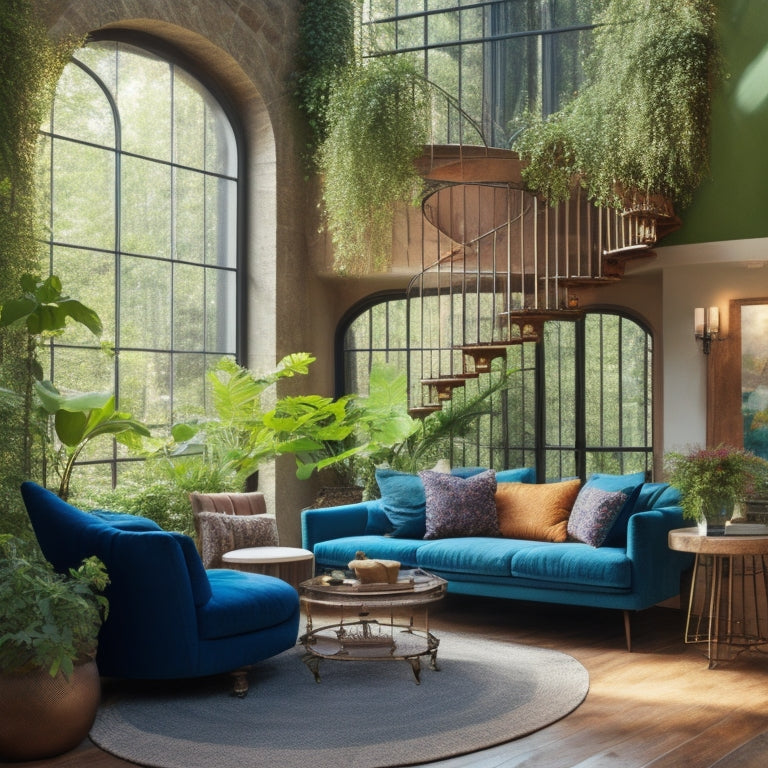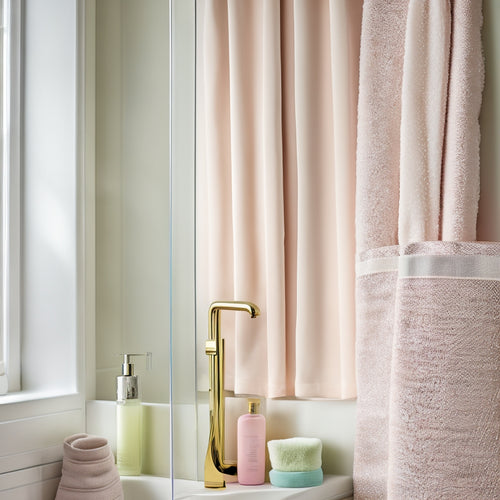
Discover the Secrets of Biophilic Home Design
Share
As you explore biophilic home design, you'll discover the transformative power of nature in your living space. By incorporating natural elements, you'll boost your mood, energy, and well-being. Imagine expansive windows, lush green walls, and reclaimed wood accents blending seamlessly with natural textures. You'll harness the uplifting effects of natural light, stimulate your senses, and breathe easy with air-purifying plants and optimized ventilation. As you harmonize your indoor and outdoor spaces, you'll uncover a profound connection to the natural world. Continue on this journey to uncover the secrets of biophilic design and awaken your senses to a deeper, more sustainable way of living.
Key Takeaways
• Incorporate natural elements like expansive windows, sliding glass doors, and lush green walls to connect with nature indoors.
• Design spaces that maximize natural light, which elevates mood, energy, and overall well-being.
• Use air-purifying plants, optimize ventilation, and consider air purifiers to create a healthier breathing environment.
• Stimulate the senses with natural materials, calming water features, and organic textures to nurture emotional and mental well-being.
• Blur the boundaries between indoors and outdoors by incorporating large windows, skylights, and plant-filled interiors to create a seamless connection with nature.
Designing With Nature in Mind
As you start designing your biophilic home, begin by embracing the natural world, incorporating elements that bring the outdoors in, such as expansive windows, sliding glass doors, and lush green walls that blur the boundaries between indoor and outdoor spaces. This fusion of nature and architecture creates a smooth shift between the two, promoting a sense of freedom and connection to the environment.
Embrace biophilic aesthetics by incorporating nature-inspired decor, such as reclaimed wood accents, living walls, and organic textures. By doing so, you'll create a harmonious balance between your living space and the natural world. This synergy won't only elevate your mood but also foster a deeper sense of well-being and connection to the world around you.
The Power of Natural Light
With every dawn, natural light pours in, illuminating your space and invigorating your senses, making it an essential element in biophilic design that can elevate your mood and energy levels.
By incorporating natural light into your home, you can reap the benefits of light therapy, which has been shown to improve mental health and regulate your circadian rhythms.
When designing your space, consider solar architecture principles, such as orienting your home to maximize natural light and using reflective surfaces to bounce light deeper into your space.
By doing so, you'll create a brighter, more uplifting environment that nourishes your body and soul.
As you bask in the warmth and glow of natural light, you'll feel more connected to nature and more at peace in your own home.
Breathing Easy at Home
By incorporating air-purifying plants and strategic ventilation strategies into your home design, you can breathe easy, free from the pollutants and toxins that can compromise your respiratory health and overall wellbeing. Indoor greenery like peace lilies, spider plants, and aloe vera can purify the air naturally, while optimizing ventilation through cross-ventilation, stack ventilation, or open windows can exchange stale air for fresh air.
| Air Purification Methods | Benefits | Tips |
|---|---|---|
| Indoor Greenery | Removes pollutants, toxins | Choose low-maintenance plants like snake plants or spider plants |
| Optimizing Ventilation | Exchanges stale air for fresh air | Open windows for 10-15 minutes daily for fresh air circulation |
| Air Purifiers | Removes pollutants, allergens | Place air purifiers in high-traffic areas or bedrooms for maximum benefit |
Sensory Experiences by Design
Designing your home to stimulate your senses can have a profound impact on your emotional and mental well-being, and it starts with intentionally incorporating sensory experiences into your space.
By acknowledging the interconnectedness of your senses, you can create a holistic design that nurtures your entire being. Consider the textures, colors, and patterns that evoke emotions and spark connections.
Incorporate natural materials, like reclaimed wood or living walls, to bring in organic elements. Don't forget about the power of sound – incorporate calming water features or natural soundscapes to create tranquility.
Bringing the Outdoors In
How do you envision bringing the serenity of the outdoors into your living space, where the boundaries between nature and interior design blur?
Imagine waking up to a lush green wall or sipping morning coffee surrounded by a tranquil garden. By integrating natural elements, you can create a seamless indoor-outdoor connection. Plant-filled interiors not only purify the air but also evoke feelings of calmness.
Consider incorporating large windows, sliding glass doors, or skylights to blur the lines between indoors and outdoors. Green space integration can be achieved through vertical gardens, living walls, or even a serene water feature.
Frequently Asked Questions
Can Biophilic Design Principles Be Applied to Small or Urban Spaces?
You can create an urban oasis in small spaces by applying biophilic design principles, optimizing space with multi-functional furniture, and incorporating natural elements like living walls, maximizing natural light and airflow for a serene, freeing atmosphere.
How Do I Choose the Right Plants for Air Quality Improvement?
You choose the right plants for air quality improvement by selecting a diverse Plant Palette that includes air-purifying powerhouses like Spider Plants and Peace Lilies, and strategically placing them for maximum Air Purification benefits.
What Are Some Cost-Effective Ways to Incorporate Natural Materials?
You can incorporate natural materials on a budget by opting for natural textiles like jute, sisal, or seagrass rugs and using reclaimed wood for accent walls or decorative shelves, adding warmth and texture to your space.
Can Biophilic Design Be Adapted to Accommodate Different Personal Styles?
You can infuse your personal style into biophilic design by mixing natural elements with your unique aesthetic, effortlessly fusing contrasting styles, and embracing flexibility in design to create a harmonious, sustainable space that reflects your true self.
Are There Specific Biophilic Design Elements Suitable for Homes With Pets?
As you design your pet-friendly haven, incorporate pet-friendly furniture with stain-resistant fabrics and hidden litterboxes to maintain a sense of freedom, while keeping your furry friends happy and your home looking fabulous.
Related Posts
-

Top-Rated Compact Shower Caddies for Small Showers
When searching for top-rated compact shower caddies for small showers, focus on space-saving designs that maximize ve...
-

Mastering Project Management Organization for Success
You know that mastering project management organization is essential for success, but it requires a strategic approac...
-

Craft Your Own Multi-Pocket Bath Caddy
We're about to craft a multi-pocket bath caddy that's both functional and stylish! To get started, we'll prepare our ...


